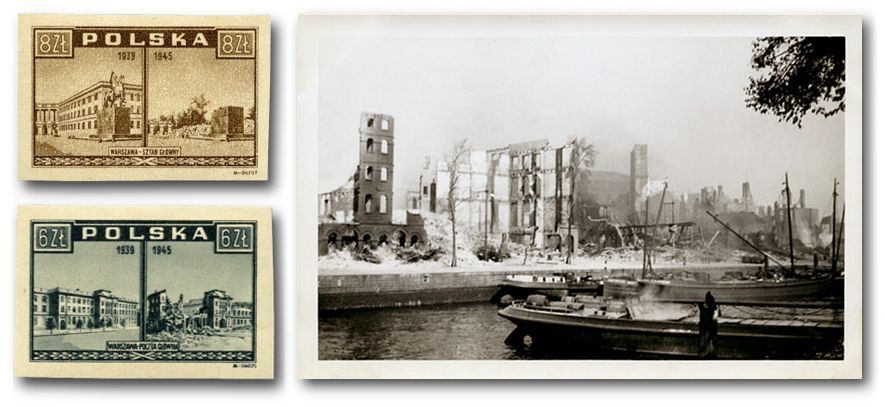The Channel Islands at War — Postage stamps as instruments of resistance
This web page was updated on January 8, 2017
The Channel Islands, anchored as they are sin the Gulf of St. Malo in the northwest of France, are geographically more akin to Europe than to the British Isles. Seven islands comprise the archipelago:

• Guernsey, officially the Bailliwick of Guernsey, embraces the islands of Alderney and Sark, each with its own parliament, and the smaller islands of Herm, Jethou and Lihou.
• Jersey, 60 km south-southeast of Guernsey.
Since the Norman Conquest and the Treaty of 1259, the Channel Islands have been aligned politically and culturally with Great Britain. Even islanders of Norman descent identify as British rather than French, and hold British citizenship, but the islands are not part of the United Kingdom. No Briton has ever been able to say that the British were actually in control. One could say of the relationship between the U.K. and the Channel Islands, “It’s complicated.”
Saint Helier is the capital of Jersey, Saint Peter Port the capital of Guernsey. Jersey’s population is about 99,000, Guernsey’s about 63,000. Their governments are known respectively as the States of Jersey and the States of Guernsey; the elected governing bodies of each are known as States of Deliberation.
Both bailiwicks have been administered separately since the late 13th century; each has its own independent laws, elections, and representative bodies, known as States of Deliberation. Any institution common to both is the exception rather than the rule.

Hitler covets the Channel Islands
Although the British government saw no strategic value in the Channel Islands, Hitler liked the idea of occupying British soil, and included them in his Blitzkrieg, the June, 1940 invasion of France and the Low Countries.
The British, deciding that the islands were indefensible, had demilitarized them two weeks previously, but communication failures within the British government prevented news of the demilitarization until June 30, which was too late: two days before, on June 28, six Luftwaffe Heinkel bombers attacked the harbours of Guernsey and Jersey to “test their defences”.
It’s not surprising that the British attempted to evacuate the Channel Islands, although their efforts were only partially successful (not quite half of the islands’ residents were evacuated to Great Britain). The British — indeed the world, aside from the Germans — had been appalled at the brutal German attacks on Warsaw and other Polish cities at the beginning of the war in 1939, and the bombing of Rotterdam in mid-May, 1940.
• The siege of Warsaw in September and October, 1939 resulted in approximately 25,800 civilian deaths, with 40 percent of the buildings in the city damaged and 10 percent destroyed. Intense street fighting between German and Polish forces caused some of the deaths and damage.
• The Rotterdam Blitz, on May 14, 1940, occurred despite a ceasefire that had taken place earlier. Numerous fires resulted and combined into a wind-driven firestorm that destroyed almost the entire historic city centre, killing nearly 900 civilians and leaving 30,000 people homeless.

Fortunately for islanders who remained on the islands (between a third and half of them had been evacuated), the attack and the subsequent occupation did not involve wholesale destruction. However, while it wasn’t a bloodbath, it was not bloodless: At Guernsey’s St. Peter Port, lorries lined up to load tomatoes for export to England were mistakenly identified as troop carriers; 44 islanders were killed. Property damage was relatively minor.
The Channel Islands under the swastika
The German occupation, which took place over four days from June 30 and July 3, 1940, altered virtually every aspect of day-to-day island life: travel abroad was banned; basic freedoms were limited; shortages of food and basic commodities, including postage stamps, began to occur; the threat of arrest loomed over anyone who challenged German authority, and thousands of resident civilians were deported to internment camps in Europesimply because they were British citizens. International mail service ended for residents, although they were eventually able to communicate via the Red Cross Message Scheme.
Throughout the occupation, some residents continued a quiet resistance, sabotaging in every way the German efforts to Nazify the islands. One fascinating aspecting of that resistance is seen today in postage stamps issued under German authority even though minuscule details served to parody and insult both Adolf Hitler and Benito Mussolini. This web page offers a close look at that particular “philatelic resistance” as well as other aspects of wartime philately in the Channel Islands.
Next, in Part 2: German authorities fail to obtain approval from Berlin to overprint British stamps (which Channel Islanders had always used) with swastikas for use in Jersey; they are equally unsuccessful in trying to print new occupation stamps for Jersey.